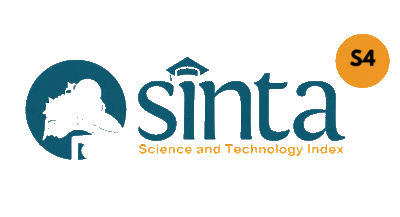IDENTIFIKASI PERFORMA ALGORITMA BLAKE3 UNTUK VALIDASI DATA
DOI:
https://doi.org/10.47111/jti.v17i1.5404Keywords:
checksum, data validation, hash algorithmAbstract
This study aims to test the ability and performance of the BLAKE3 algorithm in determining data integrity. The test will conduct a series of trials using the checksum method to obtain the hash value of a data using the BLAKE3 algorithm. The parameters tested are computation time, power consumption, CPU thread, and data size. This test shows that the BLAKE3 algorithm is able to validate data. With this test, the use of the BLAKE3 algorithm has optimal parameters that can be set in order to get the fastest and most efficient results of computing time and power consumption.
Downloads
References
S. Setti and A. Wanto, “Analysis of Backpropagation Algorithm in Predicting the Most Number of Internet Users in the World,” Jurnal Online Informatika, vol. 3, no. 2, pp. 110–115, 2018, doi: 10.15575/join.
R. I. Ciobanu, V. C. Tǎbuşcǎ, C. Dobre, L. Bǎjenaru, C. X. Mavromoustakis, and G. Mastorakis, “Avoiding Data Corruption in Drop Computing Mobile Networks,” IEEE Access, vol. 7, pp. 31170–31185, 2019, doi: 10.1109/ACCESS.2019.2903018.
J. O’Connor, J.-P. Aumasson, S. Neves, and Z. Wilcox-O’Hearn, “BLAKE3 one function, fast everywhere.” [Online]. Available: https://blake3.io
A. S. G. Andrae, “Hypotheses for primary energy use, electricity use and CO2 emissions of global computing and its shares of the total between 2020 and 2030,” WSEAS Transactions on Power Systems, vol. 15, pp. 50–59, Mar. 2020, doi: 10.37394/232016.2020.15.6.
A. M. Qadir and N. Varol, “A review paper on cryptography,” 7th International Symposium on Digital Forensics and Security, ISDFS 2019, Jun. 2019, doi: 10.1109/ISDFS.2019.8757514.
H. Roy, D. B.-I. J. of M. L. and, and undefined 2017, “Face sketch-photo recognition using local gradient checksum: LGCS,” Springer, vol. 8, no. 5, pp. 1457–1469, Oct. 2017, doi: 10.1007/s13042-016-0516-0.
Y. bin Idris, S. Adli Ismail, N. F. Mohd Azmi, A. Azmi, and A. Azizan, “Enhancement Data Integrity Checking Using Combination MD5 and SHA1 Algorithm in Hadoop Architecture,” Journal of Computer Science & Computational Mathematics, pp. 99–102, Sep. 2017, doi: 10.20967/jcscm.2017.03.007.
N. Katrandzhiev, D. Hristozov, and B. Milenkov, “A COMPARISON OF PASSWORD PROTECTION METHODS FOR WEB-BASED PLATFORMS IMPLEMENTED WITH PHP AND MYSQL.”
Kahri Fatma, Bouallegue Belgacem, Machhout Mohsen, and Tourki Rached, An FPGA Implementation and Comparison of the SHA-256 and Blake-256.
Mota Aquino Valentim, Azam Sami, Shanmugam Bharanidharan, Yeo Kheng Cher, and Kannoorpatti Krishnan, “Comparative Analysis of Different Techniques of Encryption for Secured Data Transmission,” IEEE International Conference on Power, Control, Signals and Instrumentation Engineering (ICPCSI), pp. 231–237, 2017, doi: 10.1109/ICPCSI.2017.8392158.
S. Long, “A Comparative Analysis of the Application of Hashing Encryption Algorithms for MD5, SHA-1, and SHA-512,” in Journal of Physics: Conference Series, Nov. 2019, vol. 1314, no. 1. doi: 10.1088/1742-6596/1314/1/012210.
Y.-H. Xia, H.-S. Hong, G.-F. Lin, and Z.-X. Sun, “Efficient Data Integrity Verification Using CRC Based on HDFS in Cloud Storage.”
D. Rachmawati, J. T. Tarigan, and A. B. C. Ginting, “A comparative study of Message Digest 5(MD5) and SHA256 algorithm,” in Journal of Physics: Conference Series, Mar. 2018, vol. 978, no. 1. doi: 10.1088/1742-6596/978/1/012116.
S. Sinha, S. Anand, and K. Prakasha, “Improving Smart Contract Transaction Performance in Hyperledger Fabric; Improving Smart Contract Transaction Performance in Hyperledger Fabric,” 2021, doi: 10.1109/ETI4.051663.2021.9619202.
I. Teodora Ciocan, E. Alexandra Kelesidis, D. Maimut, and L. Morogan, “A Modified Argon2i Using a Tweaked Variant of Blake3,” 2021 26th IEEE Asia-Pacific Conference on Communications (APCC), 2021, doi: 10.1109/APCC49754.2021.9609933.












